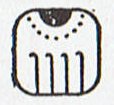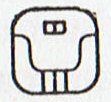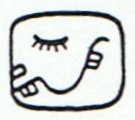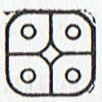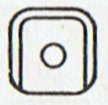|
TRANSLATIONS
Let us now recall our map over the day names:
The dog (Sirius) announces the beginning (opening) of the sky, the 'flower' opens its red 'mouth' like a sun and announces the beginning of summer (earth). The 'flower' is Zotz:
Moan has a closed mouth. Kayab has an open beak which is rather like the grasping 'hand' of 6 Manik (deer) - it is not letting any sun light out but is swallowing the last traces of sun light late in the year. It is not for output but for input (into mother earth).
The body of the deceased goes down into the earth, while the soul might raise up and become a star - cfr the quincunx sign in 7 Lamat. In 5 Cimi sun dies, in 6 Manik he is put down into the grave, and in Lamat his eternal soul goes up into the sky. The curious 'smile' in the face of 'Death' is similar in form to the opening in the hand of Manik. Both forms makes me associate to the form and function of the haga rave glyph type:
Without knowing the probable meaning of haga rave its form could not have made me associate it with Cimi and Manik, however. The corn seed is put down into earth and that may explain the curve in 3 Kan and in 18 Cumhu. Beyond the death phase earth will sink into water again: 8 Muluc. It will be drained in rain water, it seems. The deluge. The end of the world is half the time a case of being drained, while the other half of the time it is a case of being burnt to cinders. No, there is no sign of fire among these 20 days. The above is a prelude to a discussion around the connections between Muluc and Mol:
With the sun eye at center bottom as the 'hill' in Mol, the foundation of midsummer is determined as the sun. In Muluc sun cannot be seen - at least not in the ordinary way. Possibly he is depicted in the center anyhow, in his pau form (in the 'sack'). The 'sky rooof' is not open, and we can compare with the glyph for 1 Ik (air, wind), with its 'sky roof' open at right:
The words mol and muluc are similar: "This, in the general calendar, is the day Rain, but neither in the Maya Muluc nor the Tzeltal Molo or Mulu do we find any support for this meaning ..." (Gates) My feeling that the vocal difference between o and u is of no import has here been confirmed. I remember mago contra mogo (and moko) - vokals tend to change quicker than consonants. "One of the discoveries which did the most to reopen some of the important questions about the nature of the Maya script was Thompson's (1944) demonstration of the great likelihood that xoc 'count' was represented in the inscriptions by the head of a large fish, the xoc or 'shark'. Substituting for this in many inscriptions was the hieroglyph T511, also found for the day Muluc. Since the xoc shark is a patron deity of the day Muluc, Thompson assumed that the xoc head was the head form of the muluc glyph. Reasonable as this seems, it implies both a straightforward rebus use for xoc and a symbolic secondary meaning for muluc, which he apparently thinks should also be read xoc in this context, 'the symbol for water or rain representing the creature which inhabits water and in all probability gave rain to the earth' (Thompson 1950, p.163). This view neglects the fact that there is a perfectly good allograph or head variant of muluc, which is not the xoc fish, but rather the so-called kan dog. While the Yucatec day is named Muluc, equivalent days in the other languages are simply Mulu (or, in the highlands, Toh). The Quiche language seems to offer a clue to this labyrinth with the definition of mul as 'time, turn, rotation, revolution'. The counting of the year might easily appear in another context as the turning of the year ..." (Kelley) The last page of the Dresden codex (I happend to notice while watching a TV program about the end of the Mayan world cycle coming in December 2012) has a picture with water being poured from above. I have shown it earlier:
With Mol drought will come, with Muluc immersion. Is this the reason why Hanga Takaure is 'announcing' Poike (Mol)? Insects do not like drought, I guess. Hanga Hoonu could announce Muluc. But there is no water name (as far as I can understand) beyond Hanga Hoonu:
|
|||||||||||||||||||||||||||||||||||||||||||||||||||||||||||||||||||||||||||||||||||||||||||||||||||||||||||||||||||||||||||||||||||||||||||||||||||||||||||||||||||||||||||||||||||||||||||||||||||||||||||||||||


















